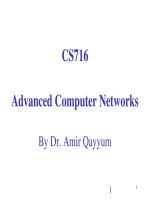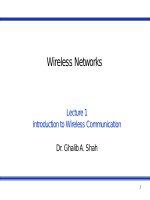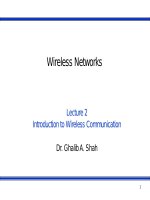Wireless networks - Lecture 37: Transport protocols/security in WSN
Bạn đang xem bản rút gọn của tài liệu. Xem và tải ngay bản đầy đủ của tài liệu tại đây (564.18 KB, 24 trang )
Wireless Networks
Lecture 37
Transport Protocols/Security in WSN Part IV
Dr. Ghalib A. Shah
1
Outlines
Transport Protocols for WSN
TCP/UDP for WSN
Protocols
► PSFQ
► ESRT
► CODA
Security Threats in WSN
TinySec
Motivations of Link Layer security
TinySec Design goals
Semantic Secure Encryption in TinySec
2
Last Lecture
Routing Challenges and Design Issues
► Deployment, Routing method, heterogeneity, fault tolerance,
power, mobility etc
Routing Protocols
►
►
►
►
►
►
►
►
SPIN
Directed Diffusion
ACQUIRE
LEACH
TEEN/APTEEN
GAF
GEAR
SPEED
3
Reliable Transport Protocols for Wireless Sensor Networks
Sink-to-Node(s) Transport
Pump Slow Fetch Quickly (PSFQ)
Reliable Multi-Segment Transport (RMST)
Garuda
Nodes-to-Sink Transport
Event-to-Sink Reliable Transport (ESRT)
End-to-End Reliable Event Transfer in WSNs
Congestion Control
Congestion Detection and Avoidance (CODA)
Mitigating Congestion in WSNs
4
Why not TCP or its variants for WSN?
Higher overheads for short data transmissions.
Flow and congestion control cause unfair bandwidth for
farther nodes.
Throughput degrades under wireless due to higher
packet losses.
End-to-end congestion needs longer time to mitigate
congestion, causing more congestion to occur.
End-to-end reliability consumes more energy and
bandwidth than hop-by-hop.
Packet-based reliability, which is not required for eventdriven applications
5
Why not UDP?
Lower over overheads but
► No congestion control
► No flow control
► No reliability
6
Pump Slowly, Fetch Quickly (PSFQ)
Nodes broadcast fragments, in-sequence to next hop,
which stores and forwards. If a node detects gap it
broadcasts a NACK. Hop-by-hop store and forward
Applic atio n
Reprogramming or retasking of sensor networks
Fe ature s
NACK, In sequence caching, Loss due to transmission
drops not congestion, Hopbyhop error recovery
Go als
Operate under high error rates, minimum support from
underlying layers, low latency, minimize no of
transmissions for lost detection and recovery
De s c riptio n
Pump, Fetch, Report Msgs
C.Y. Wan, A.T. Campbell, and L. Krishnamurthy, “PSFQ: A Reliable Transport Protocol for Wireless Sensor Networks,” WSNA'02,
Atlanta, Georgia, USA, September 28, 2002.
7
PSFQ Operations
Pump Ope ratio n
User Node broadcasts a packet to its neighbors every Tmin
Decrements TTL and schedules a transmission
►
►
Tmin
its transmission
Fe tc h Ope ratio n
Sequence number gap is detected
►
►
►
Node will send a NACK message upstream, NACK scope is 1 hop
NACKs are generated every Tr; (Tr <
Node enters ‘proactive fetch’ mode if last segment hasn’t been received
and no packet has been delivered after Tpro = a * (Smax - Smin) * Tmax
Re po rt Ope ratio n
Used as a feedback/monitoring mechanism
8
When No Link Loss – MultiHop
Forwarding takes place
1
2
1
3
4
1
2
2
1
2 2 lost
3
Recover 2
2
1
2
3
2
3
3
3
Recover 2
4
1
3
1
Recover 2
3
3
4
1
2 lost
Error recovery – Store and Forward.
2
3
2
2
3
1
1
1
1
3
Error Recovery Control Messages are wasted
Recover 2
PSFQ Pump Operation. If not duplicate and
inorder and TTL not 0 Cache and Schedule
for Forwarding at time t (Tmin
1
Tmin
Tmax
1
2
t
1
9
Tmin
Tmax
1
PSFQ
1
1
2
last1
1
2
Tr
2 lost
2
2
1
last
3
Recover 2 Tr
PSFQ Fetch Operation.
Tmin
Tmax
Tproc
last
2
PSFQ Proactive Fetch Operation.
Pro ble ms with PS FQ
Uniformly distributed channel error model
Need fine tuning of timers for good results (Tmin, Tmax, Tr)
First Packet Delivery
Cache size limitation
10
Event-to-Sink Reliable Transport (ESRT) for Wireless
Sensor Networks
S
Event-to-sink reliability
Self-configuration
Energy awareness [low power
consumption requirement!]
Congestion Control
Variation in complexity at source and sink.
[computation complexity]
11
ESRT’s Definition of Reliability
Reliability is measured in terms of the number of
packets received. Or reporting frequency i.e.,
number of packets/decision interval.
Observed reliability: number of received data
packets in decision interval at the sink.
Desired reliability: number of packets required for
reliable event detection.
Normalized reliability =observed/desired.
12
ESRT
ESRT Operations
13
Algorithm for ESRT
If congestion and low reliability: decrease reporting
frequency aggressively. (exponential decrease)
If congestion and high reliability: decrease reporting
to relieve congestion. No compromise on reliability
(multiplicative increase)
If no congestion and low reliability: increase reporting
frequency aggressively (multiplicative increase)
If no congestion and high reliability: decrease
reporting slowing (half the slope)
Drawbacks
► Event-based reporting frequency not good for all the nodes
14
CODA: Congestion Detection and Avoidance
The transport of event impulses is likely to lead to varying degrees
of congestion in the network.
CODA using channel sampling detects congestion and broadcasts
this information to upstream nodes
Applic atio n
General Purpose (eventtosink)
Fe ature s
Uses buffer occupancy and channel sampling to detect
congestion, assumes event occurrence as source of
congestion not wireless links or interference
Go als
minimize congestion both transient and persistent
De s c riptio n
Openloop hopbyhop backpressure, Closedloop multi
source regulation
15
C.Y. Wan, S.B. Eisenman, and A.T. Campbell, “CODA: Congestion Detection and Avoidance in Sensor Networks,” The First ACM
Conference on Embedded Networked Sensor Systems (Sensys03), Los Angeles, CA, USA. November, 2003.
CODA
Co ng e s tio n De te c tio n
Accurate and efficient congestion detection is important
►
►
Buffer queue length or Buffer occupancy – not a good measure of the
congestion.
Channel loading – sample channel at appropriate time to detect
congestion.
Ope n lo o p, ho pbyho p bac kpre s s ure
A node broadcasts backpressure msgs to upstream nodes as long
as it detects congestion
An upstream node decides whether to further propagate the msg
or not, depending on its own local network condition
16
CODA
Clo s e dlo o p, multis o urc e re g ulatio n
When a source event rate is greater than some max. theoretical
throughput, it is more likely to contribute to congestion, so it enter
into sink regulation
The sink sends ACKs at some predefined rate or certain no. of
ACKs over a predefined period. If source does not gets necessary
ACKs it decreases its rate.
1
2
3
1
1,2,3
4
5
2
ACK
Congestion
detected
6
Open loop, hop-by-hop backpressure
4,5,6
Congestio
n detected
7,8
ACK
Regulate
bit is set
17
Closed loop, multi-source regulation
Security threats in Sensor Networks
Use of wireless communications -In a broadcast
medium, adversaries can easily eavesdrop on,
intercept, inject and alter transmitted data.
Adversaries can Interact with networks from a distance
by inexpensive radio transceivers and powerful
workstations.
Resource consumption attacks. Adversaries can
repeatedly send packets to drain nodes battery and
waste network bandwidth, can steal nodes.
However , these threats are not addressed. Focus is on
guaranteeing message authenticity, integrity and
confidentiality
18
TINYSEC
Light weight and efficient link layer security
package
A research platform that is easily extensible
and has been incorporated into higher level
protocols.
Developers can easily integrate into sensor
network applications.
19
Motivation for Link layer security in Sensor Networks
End-End security Mechanisms :
►
Why end-end security mechanisms not suitable for sensor
networks?
►
If message integrity checked only at the destination, the networks may
route packets injected by an adversary many hops before they are
detected. This will waste precious energy.
BUT, in Sensor networks
►
Suitable only for conventional networks using end-end
communications where intermediate routers only need to view the
message headers.
In-network processing is done to avoid redundant messages-Requires
intermediate nodes to have access to whole message packets and
just not the headers as in conventional networks.
A link layer security mechanism can detect unauthorized packets
when they are first injected onto the network.
20
Design Goals-Security Goals
A link layer security protocol should satisfy three basic
security properties:
Access control and Message integrity
-prevent unauthorized parties from participating
Confidentiality
- keeping information secret form unauthorized parties
Explicit omission: Replay protection
-an adversary eavesdropping a legitimate message sent b/w 2 authorized
parties ..replays it at a some time later
21
Design goals –Performance goals
A system using cryptography will incur
increased overhead in length of the message .
Overhead limitations-REQUIRED
Increased message length results
►
►
►
►
decreased message throughput
increased latency
Increased power consumption ( Sensor Networks)
Carefully tune the strength of security mechanisms
for reasonable security while limiting overheads
22
Design Goals-Ease of Use
Security Platform► Higher level security protocols can use Tinysec to create
secure pair wise communication between neighboring nodes.
Transparency
► Application programmers are unsure of security parameters
and can disable if standardized APIs are not provided
► Should be transparent to the user
Portability
► should fit into the radio stack so that porting the radio stack
from one platform to another (ATmel, Intel, X86 etc) is a simple
job.
23
Summary
Transport Protocols for WSN
TCP/UDP for WSN
Protocols
► PSFQ
► ESRT
► CODA
Security Threats in WSN
TinySec
Motivations of Link Layer security
TinySec Design goals
Semantic Secure Encryption in TinySec
24









